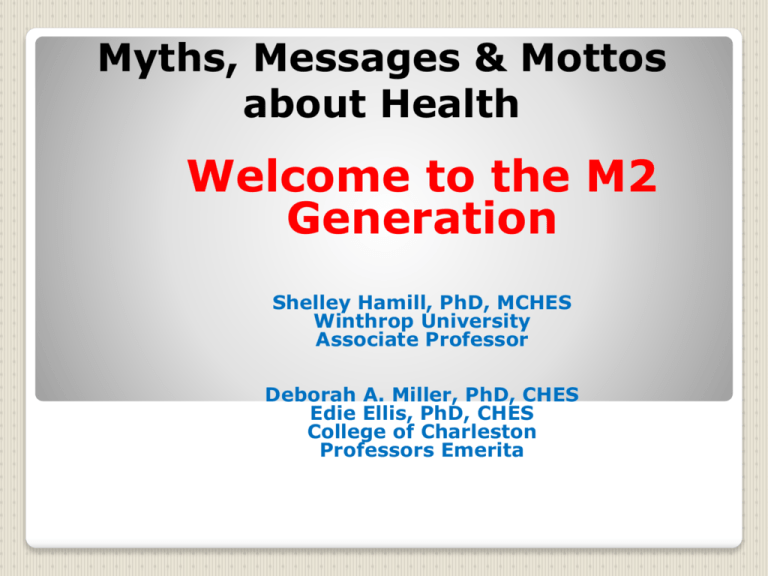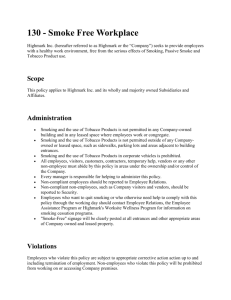
Myths, Messages & Mottos
about Health
Welcome to the M2
Generation
Shelley Hamill, PhD, MCHES
Winthrop University
Associate Professor
Deborah A. Miller, PhD, CHES
Edie Ellis, PhD, CHES
College of Charleston
Professors Emerita
Who can describe the
different types of media?
Forms of Popular Media
•
•
•
•
•
•
•
•
•
•
Digital media
Interactive media
TV programs
Computer and video
games
Films
Music
Websites
Multimedia software &
networking
YouTube
Others????
By the end of the decade there will be…
124 million U.S. households
More than 90% of teens will be online
80 million with broadband internet
55% will own a laptop
35 million satellite radio subscribers
DVRs in more than
VOD in
30 million homes
60+ million households
250 million cellular phone subscribers
A Day in the Life of a Teen
Non-school activities of 8-18 year olds
7:12
6:00
4:48
3:36
2:24
1:12
0:00
Media
With
parents
Physical Homework
Activity
Chores
# of non-school hrs./day
Rideout, V., Roberts, D.F., Foehr, U.G. (March, 2005). Generation M: Media in the lives of 8-18 Year olds. Menlo
Park, CA: The Kaiser Family Foundation.
Pervasiveness of Media
in Lives of Youth
8-18 year-olds:
◦ Average of 7 hrs,
38 min/day.
◦ More than 53
hrs/week
In Actuality
Media multi-tasking
Examples?
Packs 10 hrs,
45 min. in those
7½ hours
Media Literacy
What is media literacy?
◦
◦
AAPE =
“access/analyze/produce/evaluate”
Ask questions
How does media literacy education
impact students?
Develops critical thinking skills
Enhances understanding of media
messages
Recognizes pervasive intent of advertising
Examines popular culture and media texts
within it
Risks of Mass Media
An overwhelming
presence of alcohol,
tobacco, illicit drugs
viewed by youth
Portrays unhealthy
behaviors as
glamorous and riskfree
Poses significant
public health risk for
youth
Examples of Risk: Smoking
In a nationally
representative random
digit phone survey of
10-14 year olds, a
positive association was
found between
increased exposure to
smoking in movies and
smoking initiation.
http://www.scenesmoking.org/
Sergeant, J. (2005). Viewing tobacco use in movies. Does it shape attitudes that mediate
adolescent smoking? American Journal of Preventive Medicine. Volume 22, Issue 3.
Examples of Risk: Alcohol
A recent study of more
than 1200 films rated
G, PG, PG-13, and R,
and released between
1996 and 2003
reported that 95% of
films depicted
substances (drugs,
alcohol, tobacco)
while the Motion
Picture Association
referenced drugs and
alcohol in only 18% of
its ratings.
Do You Recall?
Something to Sing About?
Adolescents are exposed to an average of 2.4 hours of
music each day.
Researchers used data from Billboard magazine to identify
the most popular songs of 2005.
Of the 279 songs studied, 93 (33.3%) contained explicit
references to substance use, with alcohol being most
frequently mentioned, followed by marijuana.
The most common elements associated with substance use
in the lyrics were partying, sex, violence, dealing and
humor.
Only four (rock) songs portrayed a specific anti-use
message, and none portrayed refusal to use.
Music, Messages, and Alcohol
www.youtube.com/watch?v=MUTf5qvS0L
o
http://youtube.com/N=zHFiI2AEA
www.youtube.com/watch?v=GNqYWkiBHH
w&ob=av2e
The Media and Alcohol
A Look At Print Advertisements
Early 1900s
Mid-1950s
2011
Sex Always Sells!
2001
2011
Depersonalization of Women
Alcohol Ads & Sports
Behind the plate, the center field camera shows
an ad that is not seen in the ball park,
but through TV technology, the director can
insert the ad.
A Look at Other Alcohol
Messages
www.youtube.com/watch?v=7d
yfgA_xHsE
Who’s Drinking ?
YRBS 2011 found that during the
past 30 days
•39% drank some amount of
alcohol.
•22% binge drank.
•8% drove after drinking alcohol.
•24% rode with a driver who had
been drinking alcohol.
In 2011 the
National Survey on
Drug Use and
Health reported
that 25% of youth
aged 12 to 20 years
drink alcohol and
16% reported binge
drinking.
In 2011, the
Monitoring the
Future Survey
reported that 33%
of 8th graders and
70% of 12th
graders had tried
alcohol, and 13% of
8th graders and
40% of 12th
graders drank
during the past
month
Why Companies Have Changed
Their Ways of Advertising
Companies see that there is “glamour” associated with
drinking alcohol. “Characters who drink on television tend
to be well liked, professional, and wealthy.”
There are restaurants now that are known for their
drinks instead of their food, such as Squeeze & Wet
Willy’s, so they advertise in a way that makes the alcohol
seem cool and young for the “martini bar” environment.
One of the newest ways is advertising the caloric content
of alcohol to appeal to a “healthier” set of consumers.
Alcohol and the Health Bandwagon
Fact
or Fiction –
Analyze the Ads
Alcohol Ads Targeting Youth
Responsible (?) Alcohol Ads
Social Networks and Alcohol
Prevent Alcohol Postings
on Facebook
Drug Use on TV
Drugs and the Movies: 1980s
Drugs and the Movies: 2000s
Sex and TV Quiz
Examples of Risk: Sexual Behavior
There were 53 sex
episodes in 28 (32%)
of the 87 movies
reviewed.
There was only one
suggestion of condom
use, which was the
only reference to any
form of birth control.
There were no
apparent depictions of
important
consequences of
unprotected sex.
DO YOU RECALL???
Sexual
Behavior,
Innuendoes
TV Sex Symbols: Then & Now
Body Wash Ads: Then and Now
A Fable
Charlie: “Daddy, how was I born?”
Dad: “Ah, my son, I knew one day
you would need to find out.
You see, your Mom and I first got
together in a chat room on Face Book.
I set up a date via email with your
mom and we met in a cyber-café.
We sneaked into a secluded room,
where your mother agreed to
download from my hard drive.
A Fable (con’t)
As soon as I was ready to upload, we
discovered that neither one of us had
used a firewall, and…..
Since it was too late to hit the delete
button……
Nine months later a blessed little
Pop-up appeared and said…..
You’ve got male!”
Societal Sexuality Media
1950s: No Sex Please
I Love Lucy – no
pregnancy terms; no
touching
1953 Kinsey report:
Women masturbated,
had premarital sex,
cheated, 13%
homosexual
experience
Baby boom = sex
1948 Kinsey report:
Men masturbated, had
premarital sex,
cheated, 37%
homosexual contact
No guidance for
dating from TV –
Father’s Knows
Best, Leave it to
Beaver, Ozzie and
Harriet =
“traditional
values”
Advertising 1950s v. 2011
“The Pill” and the Media
Most influential factor in
sexual revolution & women’s
rights
Media = “Put me on the pill”
“Autonomous Girl”
Advertising in the 1980s
Calvin Klein jeans &
Brooke Shields
◦ “You know what
comes between me
and my Calvin’s?”....
◦ ”Nothing”
◦ Selling products by
selling women
◦ Underwear men
HIV/AIDS and STIs
Sex = Death
Music in the 1980s
Madonna
◦ http://www.youtube.com/
watch?v=VgkOCJ9PGkk
Michael Jackson
◦ http://www.youtube.com/
watch?v=0bU45ASLIGw
Tina Turner
◦ http://www.mtv.com/vide
os/tinaturner/44287/whats-lovegot-to-do-with-it.jhtml
The Gay 90s
•
•
•
•
•
1992 Banana Republic
Movies
TV
Military
Matthew Shepard
Is Social Media a Fad?
http://www.dailymotion.com/video/xdfpoy
_is-social-media-a-fad_tech
Sexting
What it is
What it does
With/without text
Cell phones & built-in cameras
The cyber tattoo
Impact of Sexting on Teens
Humiliation and harassment
Little thought of consequences
Reaction from adults?
Technology outpaces legal codes
Textual Harassment
http://www.thatsnotcool.com/
Sexual Literacy
Media literacy – Sex education
Goal
Recognize and analyze the myriad sexual messages that the
various forms of media are routinely communicating
Skills
Able to negotiate today’s sexual terrain so adolescents
can achieve positive sexual health
Letter to a Friend
Sexual
Literacy
At what
developmental
level should we
begin?
The Skin You’re In
Distorted Body Images
http://todayhealth.today.com/_
The Media and Body Image
http://www.yout
ube.com/watch?v
=7rSjh52fGTg
http://www.yout
ube.com/watch?v
=_I17cK1ltY&featu
re=mfu_in_order
&list=UL
So……
Welcome to the
M2 Generation
Sources
1.
2.
3.
4.
5.
6.
7.
8.
9.
GODBOLD, LINDA C. "Alcohol in the Media." Encyclopedia of
Communication and Information. Ed. Jorge Reina Schement. Vol. 1.
New York: Macmillan Reference USA, 2002. 18-21. Gale Virtual
Reference Library. Web. 26 Apr. 2011.
http://blog.2fresh.com/2010/08/only-one-alcohol-ad-breachescap-code.html (picture)
http://grime.shanghaiscum.com/ (picture)
http://hubbub.wbur.org/2010/11/15/boston-four-loko-ban
(picture)
http://mystuffspace.com/graphics/graphic/jack-daniels (picture)
http://pinoytutorial.com/lifebytes/national-margarita-day/
(picture)
http://www.cdc.gov/alcohol/fact-sheets/underage-drinking.htm
http://www.pewtrusts.org/uploadedFiles/wwwpewtrustsorg/Repo
rts/Alcohol_marketingand_youth/hhs_camy_state_report.pdf
http://www.presidiacreative.com/55-funny-and-clever-alcoholadvertisements/ (pictures)
Sources
10.
11.
13.
14.
15.
16.
17.
18.
19.
20.
21.
http://www.ncbi.nlm.nih.gov/pubmedhealth/PMH0001940/
http://digestivediseases.blogspot.com/2011/04/alcoholic-fattyliver-alcoholic.html
http://digestive.niddk.nih.gov/ddiseases/pubs/cirrhosis/
http://www.niaaa.nih.gov/Resources/DatabaseResources/QuickFa
cts/Liver/Pages/cirmrt3a.aspx
http://www.nlm.nih.gov/medlineplus/ency/article/000281.htm
Carithers RL, McClain C. Alcoholic liver disease. In: Feldman M,
Friedman LS, Brandt LJ. Feldman: Sleisinger & Fordtran's
Gastrointestinal and Liver Disease. 9th ed. Philadelphia, Pa:
Saunders Elsevier; 2010:chap 84.
Schuppan D, Afdhal NH. Liver cirrhosis. Lancet. 2008;371:838-851.
http://en.wikipedia.org/wiki/Alcoholism
http://www.vintageadbrowser.com/alcohol-ads-2000s
http://americasbesthistory.com/abhtimeline2000.html
Sergeant, J. (2005). Viewing tobacco us in movies. Does it shape
attitudes that mediate adolescent smoking? American Journal of
Preventive Medicine, Volume 22, Issue 3, Pages 137-145.
Sources
22. Robert Wood Johnson Foundation, Medical "Exposure to
Tobacco Marketing More Than Doubles the Odds of Children
Smoking"
December 2006 http://www.rwjf.org/pr/product.jsp?id=21886
24. Medical Research News “Tobacco giants gain $4.1 billion from
Hollywood films with smoking” March 2006 http://www.newsmedical.net/news/2006/03/17/16709.aspx
25. http://www.camy.org/research/YouthExposuretoAlcohol
AdvertisinginNationalMagazines2001- %202008/index.html
26. http://www.camy.org/factsheets/sheets/Alcohol_Advertising_
nd_Youth.html
27. http://www.marininstitute.org/alcohol_industry/ad_alert.htm
28. http://www.marininstitute.org/alcohol_industry/ad_alert.htm
29. CDC MMWR, July 15, 2011
Sources
30. www.cdc.gov/tobacco/data_statistics/fact_sheets/youth_data/
tobacco use/index.htm
31. Ashasexualitycouncil
32.www.thatsnotcool.com
33.www.thenationalcampaign.org
34.www.thestate.com/local/v-print/story/1143255.html
35.www.commonsensemedia.org
36.The Pill. American Decades. 2001. Encyclopedia.com
37.Strasburger, V.C. et al. 2010. Policy Statement: Sexuality,
Contraception, and the Media. American Academy of Pediatrices.
38.www.ncbi.nlm.nih.gov. West J Med › v.172(3); Mar 2000
39. Keynote Lecture: Virtual Sex Ed: Youth, Race, Sex and New
Media, University of Chicago | Section of Family Planning and
Contraceptive Research, June 4, 2009
40. www.womenshealth.gov/body-image






